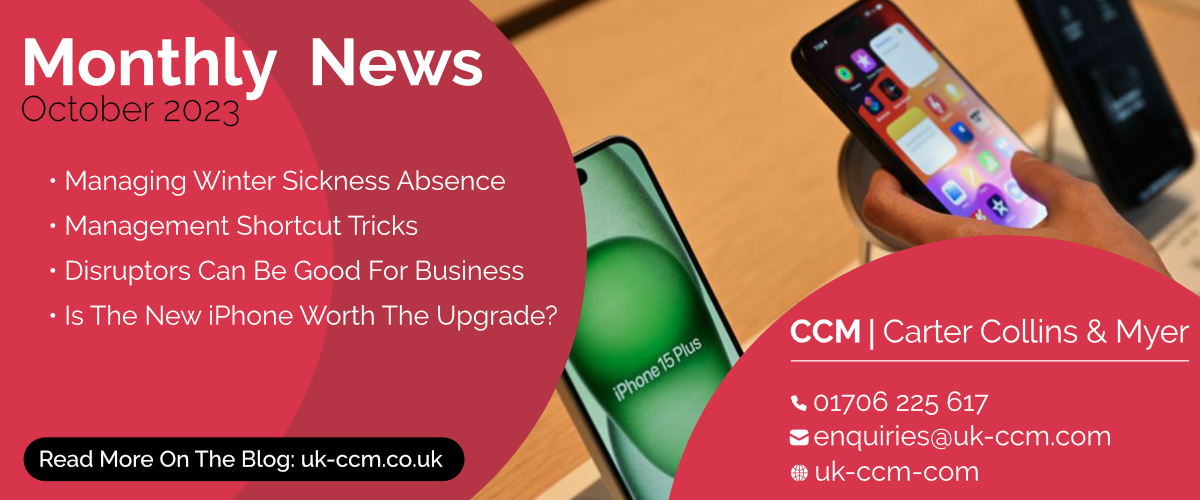Monthly News Oct 2023
Managing winter sickness absence
As winter approaches, businesses face the annual challenge of managing sickness absence effectively.
Many businesses are encouraging their employees to return to the office after years of remote working. This can be a struggle, particularly as the cold and flu season gets underway in October and November. The following steps can be taken to help your firm to manage sickness absences in the winter months:
Promoting Vaccination A vaccinated workforce is less likely to fall victim to flu-related illnesses. Provide your employees with the option to get flu vaccinations. Consider offering on-site vaccination clinics or providing information about local vaccination options.
Flexible Working Arrangements Now that remote working has become generally accepted, consider allowing employees to work from home when it's feasible. This not only reduces the risk of illnesses spreading within the workplace but also enables employees to recover and where possible, they can be productive when they are starting to feel better.
Transparent Sick Leave Policies Make sure your sick leave policies are clear and easily accessible. Employees should know how to report sick days and what's expected of them during their absence.
Wellness Initiatives Implement wellness programmes that encourage healthy habits, such as thorough handwashing, maintaining a balanced diet, and managing stress. These initiatives can reduce the likelihood of illnesses and absenteeism. You could even provide an Employee Assistance Programme (EAP) to support your employees' mental and emotional well-being during the winter season. The dark and cold months can take a toll on mental health, and EAPs offer counselling and support.
Cross-Training Consider cross-training your employees to handle each other's responsibilities. This ensures business continuity in case of unexpected absences, allowing your workforce to stay agile during busy periods. Keep the lines of communication open with your employees. Encourage them to report illnesses promptly so that the workload can be redistributed across other team members and extra resource can be allocated, if needed.
Management shortcuts
How managers can leverage the power of heuristics to speed up decision making processes. A heuristic is any approach to problem solving that employs mental shortcuts to simplify a set of circumstances to quickly reach a reasonable conclusion or solution. Heuristics are part of how the human brain is wired. The brain can only process so much information at once and it has therefore evolved to employ shortcuts.
As we learn, our brain creates practical rules of thumb so that when we encounter a similar set of circumstances again in the future, the brain can take the shortcut and reach what it sees as the most likely solution.
Heuristics facilitate timely decisions that may not be the absolute best ones but are good enough to get by. For example, when we cross a road, we learn to do so at a crossing and to wait for the green light. The brain remembers this and creates a shortcut. Next time you go to cross the road, you will instinctively wait for the green light. This is the correct approach. However, if you are crossing the road at 5am and there is no traffic, it may be safe to cross the road on a red light. The brain will not process this decision automatically and further analysis of the situation will be required, before stepping into the road.
So how can heuristics be applied in the context of managing a business? As managers gain experience and expertise over many years, they can use heuristics as a tool to tap into this expertise.
When faced with a similar situation, a manager’s heuristic may guide them to a tried and tested solution, without having to do an end-to-end analysis.
Heuristics can also help managers to manage risk. By drawing on their past experiences, they can intuitively weigh up the potential outcomes of a decision, enabling them to choose the option that aligns best with their goals and risk tolerances.
Heuristics can also help managers to allocate resources effectively. Using past experience, managers can utilise heuristics to quickly identify which projects or initiatives are likely to result in the most significant returns.
They can also use heuristics to make assessments on how much resource will be needed in order to successfully complete a project in a timely manner.
Heuristics can help managers to speed up decision making but they should also be used with caution. Over reliance on heuristics can lead to errors of judgement and bias.
Therefore, it is important to understand when to use heuristics and when to employ more in-depth analysis, depending on the complexity and risk association with a particular decision.
Be the disrupter
Disrupters are the firms that come up with new ideas and challenge the way things are done. In order to become a disrupter in your market, your firm must be prepared to innovate relentlessly, challenge norms and redefine industry standards. If you want to succeed, you need to understand your target audience, their needs, pain points and aspirations. Start by mapping your typical customer’s journey and consider where the bottlenecks are in the sales process. These areas could be ripe for innovation. For example, if you sell business services and require your customers to sign an engagement letter, you could make life easier for your customers by allowing them to use e-signatures to sign the engagement letters online.
Create a culture that encourages creativity in your firm. Encourage your team to think beyond the ordinary, brainstorm ideas, and experiment boldly. Being a disrupter often necessitates the courage to be different. Mistakes will happen but they should be embraced as opportunities to learn.
A customer-centric ethos is paramount. Your customers should be the compass guiding your strategy. Endeavor to understand their needs and preferences. Customer feedback can be invaluable in refining your products or services so don’t be afraid to ask your customers to share their thoughts.
Incorporating emerging technologies into your business model can create a formidable competitive advantage. Technologies such as Artificial Intelligence, Augmented Reality and Blockchain have the potential to revolutionise industries. Consider how these technologies can be harnessed to reshape your industry's landscape.
Data analytics are a powerful tool that can be used to glean insights into customer behaviour, market trends and emerging opportunities. Data- driven decision making can help your firm to spot gaps in the market and target new customer segments. If this is backed up with a robust and authentic brand identity, your firm can carve a distinctive niche in a particular market.
Analysing data can help you to refine your brand values, service offering or pricing model, in order to closely align with the needs and wants of your customers, thereby making your firm a more compelling choice in the market.
iPhone 15
Is it worth the upgrade? The new iPhone 15 is here, and it looks pretty much the same as the iPhone 14. There is a standard version and a Pro version. There is the option of a 6.1-inch display or a 6.7-inch display (just like on the iPhone 14). There are various colours to choose from and the camera is pretty similar.
There are a few interesting new features on the iPhone 15 which may encourage those with older devices, to decide to upgrade. The big news is that Apple has switched from the traditional lightning connector to a standard USB-C connector. Moving to a standard connector makes sense as most other devices including laptops and headphones all use USB-C cables.
Apple has suggested that the iPhone 15 should have all day battery life and the official statistics are up to 20 hours video playback on the 6.1-inch model and 26 hours on the 6.7-inch model. Both the iPhone 15 and 15 Pro come with powerful processors but unless you are a gamer or use power-hungry photo editing apps on your iPhone, you are unlikely to see any significant difference in performance.
The Pro version of the iPhone 15 is now made from titanium rather than aluminium. The new material looks great but in reality, most people put a case on their phone to protect it so the new finish is unlikely to be seen. The iPhone 15 Pro is noticeably lighter in weight than the iPhone 14 Pro and this is almost entirely down to the titanium case.
The iPhone 15 is a premium device and starts at £799 for the basic 6.1-inch version. The iPhone 15 Pro starts from £999 for a 6.1-inch rising to £1,199 for the 6.7-inch iPhone 15 Pro Max.
The iPhone 15 models offer plenty of storage, from 128GB up to 1TB but the extra storage costs more. An iPhone 15 Pro Max with 1TB of storage costs a whopping £1,599.
If you want the latest and greatest smartphone the iPhone 15 range offers just that. However, a more sensible option would be to buy last year’s iPhone 14 which starts at a more reasonable £699 and offers most of the same features. It looks similar, has similar capabilities, the battery life is good and the camera takes good pictures. For most business users, that’s all that matters.

